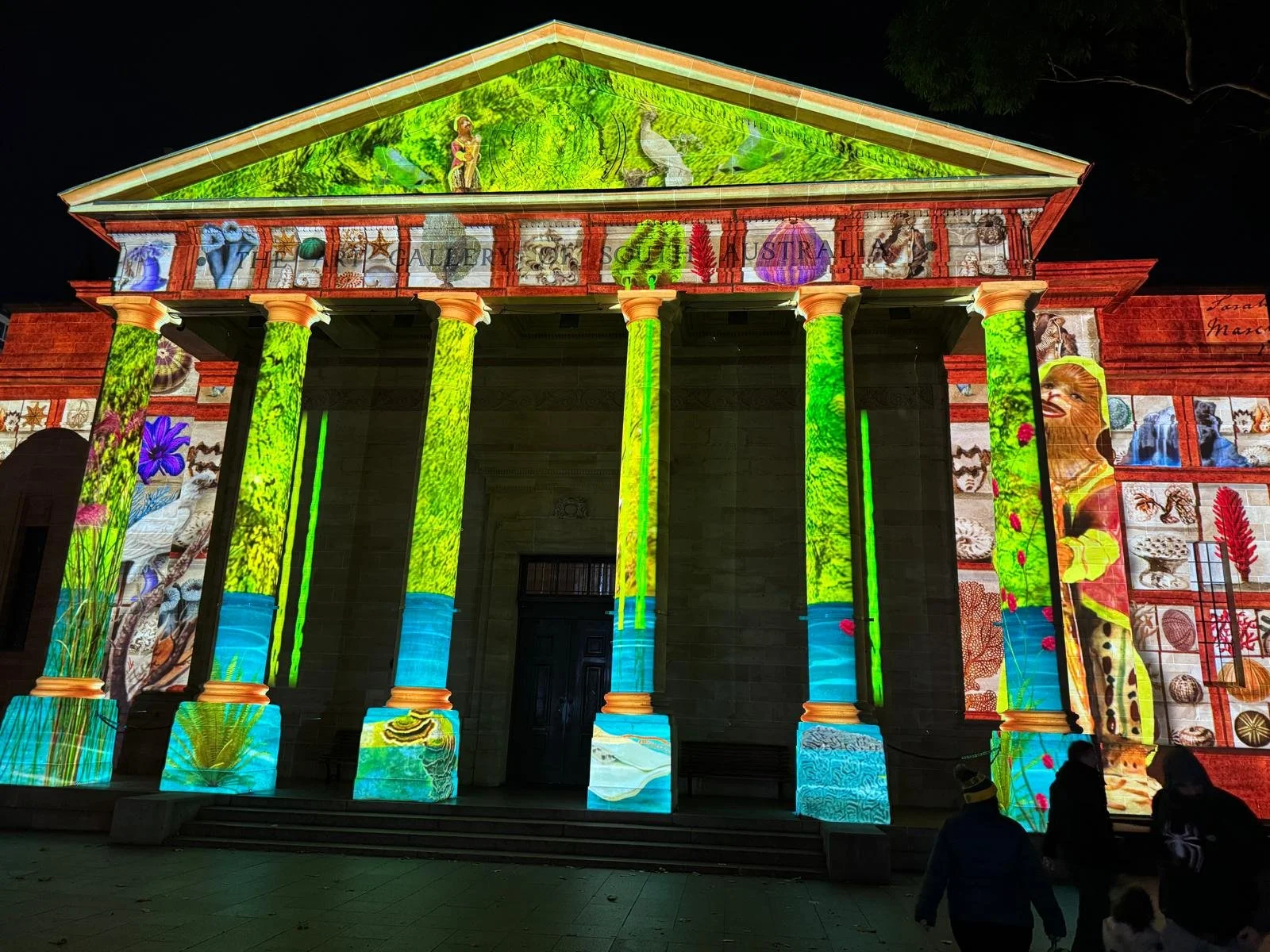REAIE Landscapes of Collaboration: New Possibilities for Education in Complex Times: Reflection Two
July 11, 2025 | Authors: Katherine Williams and Tania Lattanzio
Photo: Projection on the Art Gallery of South Australia “I Give You a Mountain”by Joan Ross: As part of the Illuminate Adelaide City Lights
What a joy it was to be part of the Landscapes of Collaboration: New Possibilities for Education in Complex Times conference, hosted by the Reggio Emilia Australia Information Exchange (REAIE).
These are indeed complex times in education and we are all feeling this in different ways in our different contexts all over the world. Being surrounded by educators so deeply committed to honouring the rights, voices, and potential of children was humbling, inspiring and hopeful. A particular highlight was listening to the powerful words of Consuelo Damasi, atelierista, and Elena Maccaferri, pedagogista, from Reggio Children in Reggio Emilia, so beautifully and respectfully translated by Jane McCall.
This experience served as a powerful reminder of the importance of pausing to reflect, not only on what we do, but on why and how we do it. In the spirit of the Reggio Emilia philosophy, reflection is not an add-on. It is a way of thinking, a way of being, and a powerful tool for transformation.
In that spirit, we will be co-writing a series of blog posts as a way to reflect, learn, grow, and share this experience with others. We hope to capture the richness of what we encountered and the many proposals we are still sitting with.
To be there listening, connecting, participating and engaging in such meaningful dialogue was a true privilege.
Reflection Two: “Children are Intelligent Researchers”: Consuelo Damasi
When we speak about the “One Hundred Languages”, we want to be clear that every language has equal value and dignity with all the other languages. Schools may place emphasis on written, spoken and read language however these are not more important than the other languages children use to know and understand the world around them. How are we the adults bringing an “aesthetic dimension” to children’s learning?
Through her keynote presentation, Pedagogy and Art: A Transformative Dialogue, Consuelo Damasi invites us to enter in, notice and listen to children’s “intelligent research” - adults always looking for narrative clues and collecting the clues to the stories children tell. At Reggio Children, the adults are not wanting to fall back on habits but keep a high degree of tension and research to learn new things. One simple example shared was showing children a flower as it is dying and wilting instead of in full bloom. The children engaged in drawing the flower as it died and using the material of transparent paper invited children to show the passing of time by layering their drawings on top of each other as if to show movement in the decay. These seemingly simple pedagogical decisions, made with intention and purpose, bring out the complexity and depth in children’s thinking and learning. This approach can be applied to our own contexts in infinite ways.
In Elena Maccaferri’s keynote session, The Image of the Child and the Right to Participation, she talks about the need for adults to be always working with a level of complexity. This looks like always keeping questions in mind, designing contexts for conversation and dialogue for everyday lives, working on our roles as adults and the questions we ask children.
Extending this thinking further, we must consider the concept of intelligent materials, materials chosen not for their decorative appeal, but for their capacity to provoke thought, curiosity, and research. Offering children palettes of materials invites them to engage in self-directed investigation, formulate hypotheses, and express evolving theories. It is through their interaction with these materials that children’s ideas take shape and deepen.
As adults, our role becomes that of the intentional researcher, listening and observing not just for what is said, but attending to gestures, silences, movements, and what Elena Maccaferri refers to as “implicit and embodied questions” posed by children.
We must engage in what Reggio educators call a “clever use of materials,” designing environments that afford opportunities for thinking and conceptual exploration. Consuelo Damasi reminds us that this requires framing our interpretations tentatively; “It seems…” or “It appears…” as we are always constructing meaning from children’s thinking.
This thinking is key: we are forming theories about children’s provisional theories, their current ways of making sense of the world. These become the basis for designing further learning experiences that extend and challenge those theories.
Children are enthusiastic about challenges; they are not waiting for answers, but for meaningful proposals, thoughtfully designed invitations to advance their thinking. The language we use, and the questions we pose, both expressed and unspoken, can open or close possibilities for meaning-making.
In honoring the Hundred Languages and embracing a pedagogy of listening, intelligent materials, and provisional thinking, we foster a culture where complexity is not only accepted, but expected, where children are valued and seen as “Intelligent Researchers.”


